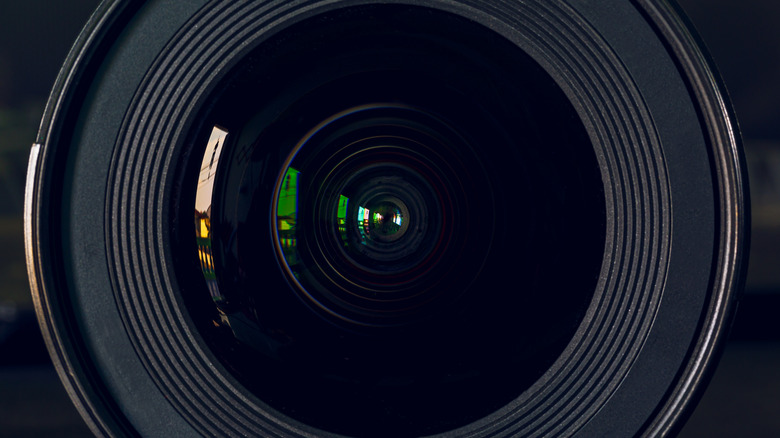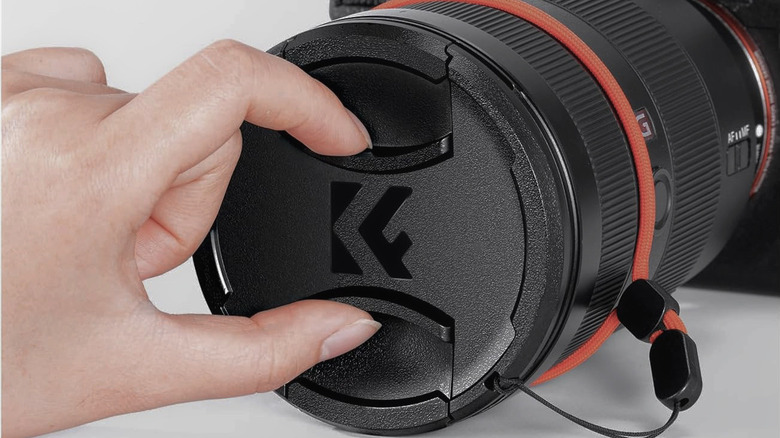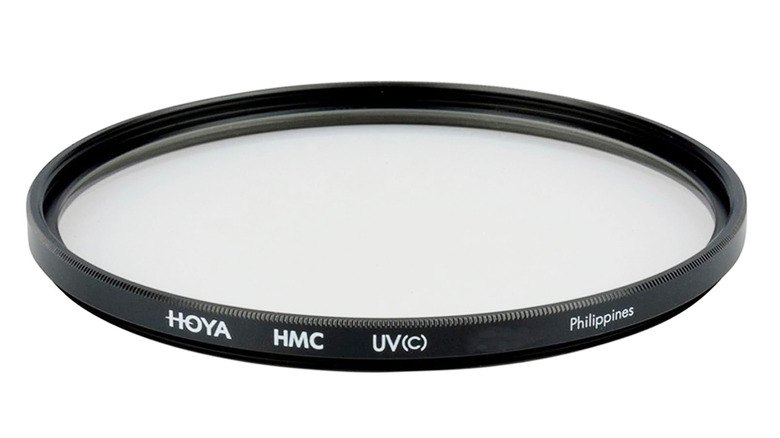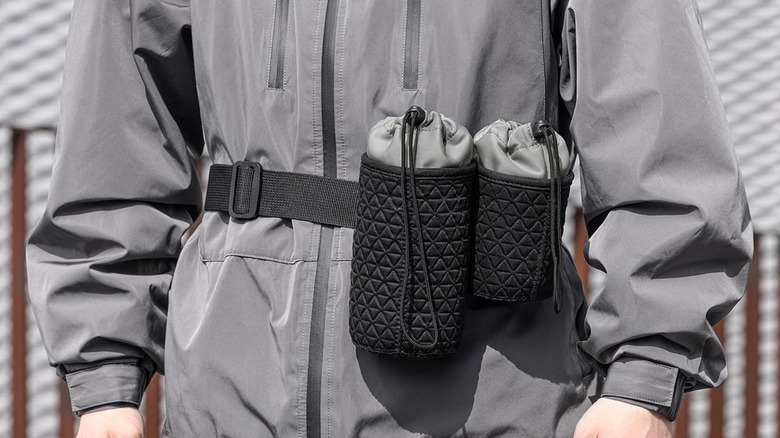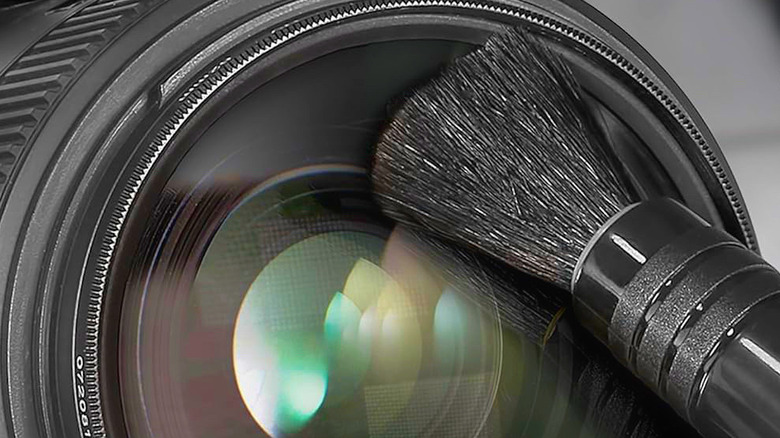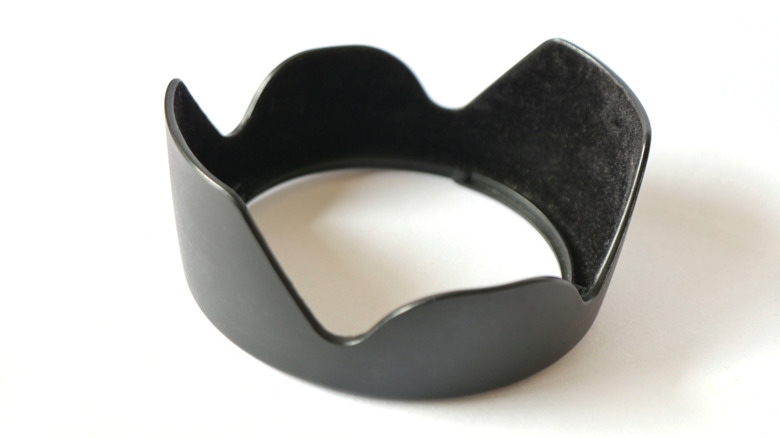5 Camera Lens Accessories You Need To Protect Your Gear
We may receive a commission on purchases made from links.
If you own decent camera gear, you'll want to keep it in decent shape. In fact, with the costs involved in photography equipment, you'll want to keep it in tip-top shape. And you'll want it in that condition for as long as possible, too. However, mishaps happen to even the most careful photographers. Dust, moisture, a knock against a doorframe — it really doesn't take much to damage the front element. And fixing it isn't exactly something you can do with that change you've saved up in the jar on the kitchen counter.
Lenses are particularly expensive, especially major brands. They are typically the most expensive photography gear after the camera body itself. In many cases, high-end glass can even cost more, and replacing one because of an amateur mistake is a lesson you'll want to learn only once. It's even worth being a little proactive when it comes to protecting your pricey optics. Spending a little on the right accessories up front could save you a ton in the long run.
Buying lens accessories to protect your glass is absolutely not about buying unnecessary extras. It's just common sense because a few basic items can save you a lot of frustration and money, since these straightforward, practical accessories do not cost an arm and a leg. In fact, for the majority of them, you could finally get around to counting out that coin jar and spending it on something worthwhile.
Lens Cap
Let's start with the obvious. A good lens cap is fundamental in lens protection. It's the simplest way to protect your investment, and it guards the glass against scratches, dust, and minor collisions whenever you're not shooting. You should always have a cap on the front when you store or transport your lens — even everyday dust can leave marks on the optics. Most lenses do come with one included, but they are easy to lose or break, and it's much cheaper to replace the lens cap than it is a damaged lens.
Unless your lens is fixed, you shouldn't forget about the rear lens cap, too. It protects the delicate glass and electrical contacts at the back from dust, debris, and scratches that can have an effect on image quality and autofocus accuracy. If you ever need to replace this, you need to get one that matches your specific lens mount. But, front or rear, it's always good practice to regularly check your caps for cracks or whether they still fit snugly. You should also clean them periodically to avoid the transfer of dust or grime.
When choosing a front lens cap, snap-on designs that attach inside the filter thread are generally best. They're more secure than the push-on type that slides over the outside of the barrel. The K&F Concept Professional Lens Cap ticks all the boxes and offers outstanding value. It's a 4-in-1 kit that includes a snap-on center-pinch cap that's easy to attach and remove, a leash to tether it to the lens, and two microfiber cloths for safe cleaning. It's available in a wide range of sizes to ensure a precise fit, but you should double-check for compatibility.
UV filter
In the past, UV filters were essential for blocking the ultraviolet light that caused haze and blue coloring in photos. Nowadays, modern sensors and advanced lens coatings already block most UV light, so it's up for debate whether they are necessary for this purpose any more. But they do remain a popular accessory for lens protection. One tip to make your gear last a lifetime is to thread a UV filter onto your lens to safeguard against dust, dirt, moisture, fingerprints, and scratches, as well as accidental drops and impacts. However, at certain times, such as when shooting at high altitudes, it's not unheard of for UV light to still cause a bit of atmospheric haze or a subtle blue cast. In such cases, a good UV filter will help reduce these effects a little and give your images a cleaner, sharper look. But it still primarily acts as the first line of defense, and just like the lens cap, they are much cheaper to replace than the lens itself.
Make sure you choose carefully. Low-quality filters can cause image problems like flare, ghosting, or vignetting. One might even reduce the sharpness, especially if you have it stacked with other filters like a CPL or ND. That's why you should look to spend a little extra on a UV filter made with high-quality optical glass with multi-layer and anti-reflective coatings. The Hoya UV Filter meets these needs. It's made with multi-coated glass to minimize reflections, flare, and ghosting and offers around 97% light transmission to boost contrast and balance color in addition to that vital protection. It's available in a wide range of sizes for simple compatibility and is a reliable, quality choice from a revered brand.
Lens pouch
You might think you can just throw your glass in a camera bag without the added protection of a lens pouch. And you'd be right. But a lens pouch, or lens case, or lens bag, whatever you want to call it, is a smart way to double-ensure you keep your gear in good shape. It's a no-fuss accessory that protects against humidity, dust, dirt, oil, and all the other stuff that could end up scratching or fogging your precious glass. So, don't just toss those lenses loose in the bag — give them a safe place and prevent damage that could ruin their focus and clarity.
There are different options to consider. Hard-shell cases with foam padding are one. They're solid, offer water resistance, and are a good choice for serious travel photography, although they tend to be a bit bulky and don't offer as much carrying flexibility as other types. Softer nylon or polyester options are lighter and more forgiving on space. They're also tough and stay in good shape even with rough use. Genuine leather is one to avoid, however, as it holds moisture that can breed mold or fungus.
Whichever style you go for, make sure the fit isn't overly tight. Not only because it can make swapping lenses more of a hassle, but also because it can wear out the rubber grip rings over time. The K&F Concept 4-in-1 Lens Pouch is well worth a look. It's a set of pouches made from durable, scratch-resistant polyester that covers multiple lens sizes. Each pouch closes securely with a drawstring and features belt straps and hooks to give you different carrying options.
Lens cleaning kit
A lens cleaning kit won't be the flashiest item in your camera bag, but you'll be kicking yourself if you forget it. Dust and smudges can soften shots, kill contrast, and, if they're bad enough on the rear lens, even throw off the autofocus. Whether you like it or not, regular, careful cleaning is just part of looking after your gear properly. It doesn't need to be complicated, either; the basics are what matter.
Start with a simple blower to get rid of loose dust. Use one over a cloth, because these can grind grit into the glass. A soft brush comes next. Use it to gently sweep away whatever is left without the risk of scratching. If you have any pesky fingerprints or oily smears, use an alcohol-free cleaning solution with a microfiber cloth or lens tissue and gently wipe in a circular motion from the center out to the edges. You might also want to do this in a clean environment so you don't just add to the problem.
The Altura Photo Professional Cleaning Kit has everything you need, and SlashGear listed it in 2024 as one of the best reviewed on the market. It's compact enough to live in your camera bag without fuss and does exactly what you need it to do. A good complementary addition to any lens-cleaning kit is silica gel. It helps to control moisture inside your camera bag and prevents the humidity that can cause fogging, mold, or fungus on your carefully cleaned glass. Dry & Dry offers a plethora of package sizes so you can stash the little sachets anywhere from your camera bag to storage drawers. They'll absorb all that harmful humidity and will contribute to the long-term protection of your glass.
Lens Hood
Some beginners may see it as a total waste of money, but one of the simplest ways to improve your shots while keeping your lens safe is to use a lens hood. Its main job is to block stray light that can cause flare, which are those washed-out streaks or spots that reduce contrast and make photos look flat. By shading the front element, it ensures only the light you want reaches the sensor, giving your shots stronger contrast and cleaner detail. They're an asset even in tough conditions like shooting into backlight or when you're snapping away near street lamps at night.
But beyond that, a lens hood is a reliable piece of physical armor. It extends past the glass, taking the hit if you accidentally bang your camera against a railing or doorway. If you're shooting in crowded markets or at busy events, it can act like a defensive barrier, reducing the chance of scuffs or direct impacts. Even when you're taking photos in the rain or snow, it helps by keeping droplets off the front element so you're not constantly wiping it and risking scratches in the process. It's a simple layer of insurance, and as it's often included with new lenses, it's essentially free protection. But if you lose or break it, you'll need to find another exact match in order to get the right fit for your lens.
